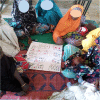Whose knowledge counts? Involving communities in intervention and trial design using community conversations
- PMID: 37287035
- PMCID: PMC10249250
- DOI: 10.1186/s13063-023-07320-1
Whose knowledge counts? Involving communities in intervention and trial design using community conversations
Abstract
Background: Current debates in Global Health call for expanding methodologies to allow typically silenced voices to contribute to processes of knowledge production and intervention design. Within trial research, this has typically involved small-scale qualitative work, with limited opportunities for citizens to contribute to the structure and nature of the trial. This paper reports on efforts to move past typical formative trial work, through adaptation of community conversations (CCs) methodology, an action-oriented approach that engages large numbers of community members in dialogue. We applied the CC method to explore community perspectives about pneumonia and managing the health of children under-5 in Northern Nigeria to inform our pragmatic cluster randomised controlled trial evaluating a complex intervention to reduce under-5 mortality in Nigeria.
Methods: We conducted 12 rounds of community conversations with a total of 320 participants, in six administrative wards in Kiyawa Local Government Area, Jigawa state, our intervention site. Participants were male and female caregivers of children under five. Conversations were structured around participatory learning and action activities, using drawings and discussion to reduce barriers to entry. During activities participants were placed in subgroups: younger women (18-30 years of age), older women (31-49 years) and men (18 years above). Discussions were conducted over three 2-h sessions, facilitated by community researchers. Following an initial analysis to extract priority issues and perspectives on intervention structure, smaller focus group discussions were completed with participants in five new sites to ensure all 11 administrative wards in our study site contributed to the design.
Results: We identified enabling and limiting factors which could shape the future trial implementation, including complex power relationships within households and wider communities shaping women's health decision-making, and the gendered use of space. We also noted the positive engagement of participants during the CC process, with many participants valuing the opportunity to express themselves in ways they have not been able to in the past.
Conclusions: CCs provide a structured approach to deep meaningful engagement of everyday citizens in intervention and trial designs, but require appropriate resources, and commitment to qualitative research in trials.
Trial registration: ISRCTN39213655. Registered on 11 December 2019.
Keywords: Community conversations; Community engagement; Formative research; Participation; Trials; Under-5 pneumonia.
© 2023. The Author(s).
Conflict of interest statement
HG, EM and CK are advisors to Lifebox Foundation on pulse oximetry. AAB, AGF and HG are board members for Oxygen for Life Initiative (OLI), a private non-profit that has provided services to the INSPIRING project. IH and PV are employed by Save the Children UK who are part of the partnership funding the research. TFO and MM are employees of and stockholders in GSK, a multinational for-profit pharmaceutical company that produces pharmaceutical products for childhood pneumonia, including a SARS-CoV2 vaccine.
Figures
References
-
- WHo . Declaration of Alma-Ata. 1978. - PubMed
-
- World Health Organization . Community engagement: a health promotion guide for universal health coverage in the hands of the people. 2020.
Publication types
MeSH terms
Grants and funding
LinkOut - more resources
Full Text Sources
Medical
Miscellaneous




